Garden Tour

From 1974 to 1984, Marilee and I ran a 7 acre organic farm a mile down the road from Watkins Glen, NY, race track. We raised fruit, vegetables, maple syrup, bees, chickens and Black Angus beef, almost everything we ate for ten years (except milk which we got raw from the dairy next door). Our 60 x 160 basic vegetable garden was one of the finalists in PBS’s Victory Garden show’s search for the best home garden in America. Our yard sale when we moved included tractor, mower, snow blade, tiller, ten foot hauling trailer, and lots of other practicalities.
We returned home to California to discover West Coast residential lots are seldom suitable for large scale agriculture. Even a big lot, if it’s on the ocean, is unfriendly to veggies. But California’s Mediterranean climates are a flower gardener’s paradise, so food was replaced by diversity and color of trees, shrubs, perennials and annuals. Currently we have 250± varieties of plants in pots or the ground, with about 100 varieties in bloom at any given time. December 8th, 2005, when this was first drafted, I counted 136 different flowers in bloom.
We were in our 50’s when we planted our first flower and over the course of fifteen years the garden and we have grown old together, both benefitting from the association. We ask a lot of questions and have had suggestions and sweat equity from others. Special thanks to Ray Walsh for help starting the design and Jerry Dailey for a decade of hard labor and clever solutions to problems when helping build infrastructure.
Vegetable gardening for survival was an outstanding experience, but growing plants to make the world prettier, or simply to see how they grow, has been a treat for us. To net-share that experience, I strolled through the garden taking low res quickie pix...digi-snaps. a tiny tour walking some of the paths and places. Most pictures were of the garden late afternoon on December 6, 2005. With a few additions.
Entering the garden from South entrance landing.
April 23, 2005
Looking West from Garden mid-point, April 23, 2005
Same view, December
Central fountain, looking South. The rose garden is to the left, an Australian tea tree straight ahead, the wild garden to the right and the agave behind. The fountain proved to be irritatingly noisy. One sagacious soul was heard to say, “Sounds like a horse [deleted] on a flat rock.”
I agreed and disconnected it.
Down the central path to the Southern landing and beach. Beach stairs go down right; to the left is the wedding point. The arch is an agave flowering stem. Looking South-Southwest, Vandenburg AFB is seen across the water on a clear day. April 23, 2005
Sunset season is late Fall and early Winter, roughly October thru January.
Agaves take approximately 18 months to flower. A 15” band of small yellow flowers grows from the bottom to the tip, leaving dead flowers in its wake (note the brown dead flowers on the center plant). The slow cycle allows this arid-living plant to spread seed through an entire year, increasing its chances to reproduce. The plant dies after flowering.
The great snowstorm of 2006 was actually pea sized hail, two inches deep in places. The grey-blue agave is what tequila is made from. This particular specimen is about 8 feet tall.
Southern border path, looking back toward the
entrance landing to the Garden.
This completes a brief tour of the gardens.


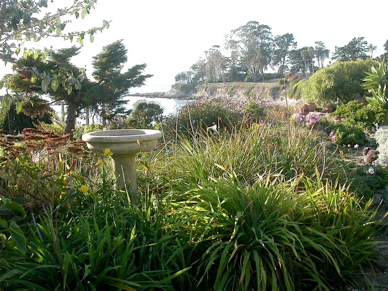
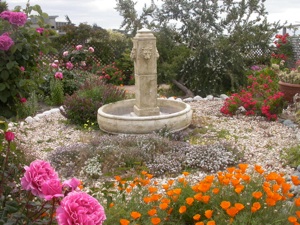
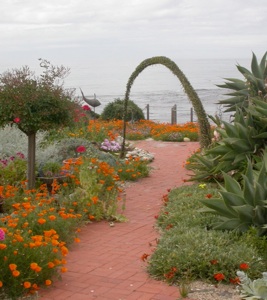
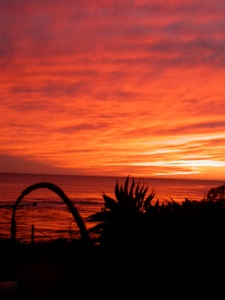
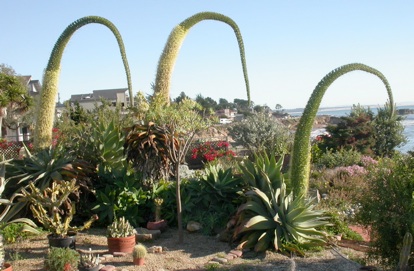
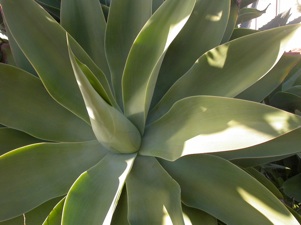
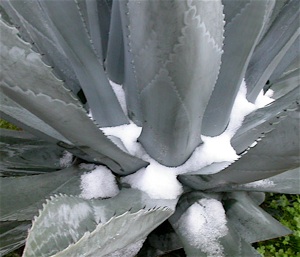
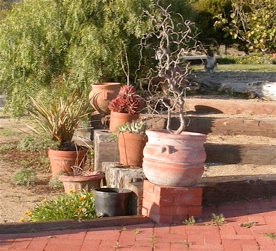
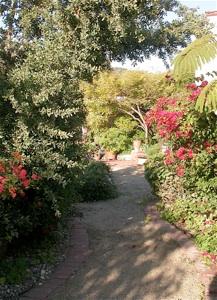
The cactus and agave are at the top of these stairs to the right. The pilings used for the stairs and terracing were salvaged when the Unical pier collapsed in the storm of 1983.
Gift of Skeeter Baldwin. Installed by Jerry Dailey.
